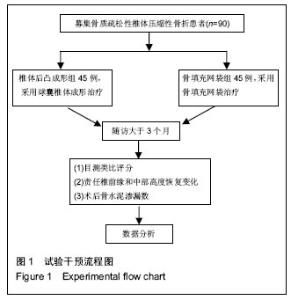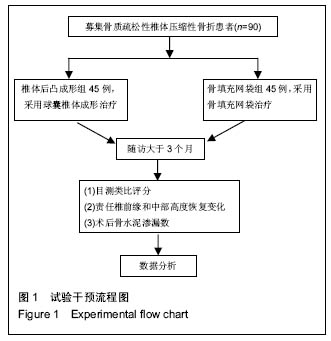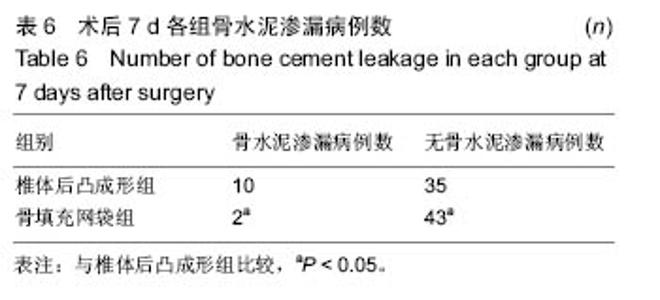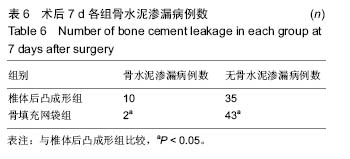Chinese Journal of Tissue Engineering Research ›› 2016, Vol. 20 ›› Issue (52): 7858-7864.doi: 10.3969/j.issn.2095-4344.2016.52.015
Previous Articles Next Articles
Bone filling mesh container versus balloon percutaneous kyphoplasty repairs osteoporotic vertebral compressive fracture
- 1Department of Spine Surgery, Affiliated Hospital of Binzhou Medical University, Binzhou 256603, Shandong Province, China; 2Department of Orthopaedics, Binzhou People’s Hospital, Binzhou 256610, Shandong Province, China
-
Received:2016-10-06Online:2016-12-16Published:2016-12-16 -
Contact:Geng Xiao-peng, M.D., Associate professor, Department of Spine Surgery, Affiliated Hospital of Binzhou Medical University, Binzhou 256603, Shandong Province, China -
About author:Fu Guo-yong, Studying for master's degree, Department of Spine Surgery, Affiliated Hospital of Binzhou Medical University, Binzhou 256603, Shandong Province, China -
Supported by:the Program of Medicine and Health Science Technology of Shandong Province, No. 2013WS0300
CLC Number:
Cite this article
Fu Guo-yong, Geng Xiao-peng, Wang Xia, Li Xue-cheng, Gao Sheng, Niu Chong, Dou Yong-feng, Zhu Kai.
share this article

2.4 两组治疗前后在目测类比评分、Cobb角椎体高度与骨水泥渗漏方面对比 两组术前术后组内指标比较:目测类比评分、Cobb角,椎体高度手术前后比较均差异有显著性意义(P < 0.05)。提示两组术后较术前在缓解疼痛、纠正后凸畸形和恢复椎体高度方面疗效显著。说明两种手术对于骨质疏松性椎体压缩性骨折患者在缓解疼痛、纠正后凸畸形和恢复椎体高度方面作用疗效确切,达到了治疗的目的。术后7 d,1个月,末次随访在目测类比评分和Cobb角方面差异无显著性意义(P > 0.05)。提示术后即时疗效与恢复期疗效相似,说明近期效果满意,术后恢复期在疼痛缓解、纠正后凸畸形、恢复椎体高度方面改善效果不明显。 两组组间指标比较:两组目测类比评分、?目测类比评分差异无显著性意义(P > 0.05;表3),提示两组在缓解疼痛方面效果相似,说明两种手术方式都达到了缓解骨质疏松性椎体压缩性骨折患者疼痛的目的,且疗效相似。术后两组Cobb角、椎体高度均差异有显著性意义(P < 0.05),在恢复椎体高度方面,骨填充网袋组优于椎体后凸成形组(表4,5),提示经皮椎体后凸成形组在恢复椎体高度和纠正椎体后凸畸形方面优于骨填充网袋组,说明在治疗骨质疏松性椎体压缩性骨折恢复椎体高度和纠正椎体后凸畸形方面经皮椎体后凸成形组的疗效优于骨填充网袋组。术后经皮椎体后凸成形组骨水泥渗漏数10例,其中硬膜外骨水泥渗漏3例、椎旁渗漏2例、椎间隙渗漏5例;骨填充网袋组骨水泥渗漏数2例,均为椎间隙渗漏;椎体后凸成形组渗漏数多于骨填充网袋组(P < 0.05;表6),说明在治疗骨质疏松性椎体压缩性骨折预防骨水泥渗漏方面,骨填充网袋组较经皮椎体后凸成形组作用显著。经皮椎体后凸成形组采用单侧穿刺45个椎体,其中有34个椎体骨水泥越过中线到达对侧,以穿刺侧分布较多;骨填充网袋组单侧穿刺的45个椎体中,有6个见少量骨水泥越过中线到达对侧,大部分椎体骨水泥主要局限在穿刺侧。 "

| [1]Johnell O, Kanis J A. An estimate of the worldwide prevalence and disability associated with osteoporotic fractures. Osteoporos Int. 2006;17(12): 1726-1733.[2]Kado DM, Duong T, Stone KL, et al. Incident vertebral fractures and mortality in older women: a prospective study. Osteoporos Int. 2003;14(7):589-594.[3]梁德,叶林强,江晓兵,等.骨水泥-椎体体积比及椎体骨壁裂口与椎体成形骨水泥渗漏的相关性分析[C].第十届中国南方骨质疏松论坛暨重庆市医学会骨质疏松年会,重庆,2014.[4]Gu CN, Brinjikji W, Evans AJ, et al. Outcomes of vertebroplasty compared with kyphoplasty: a systematic review and meta-analysis. J Neurointerv Surg. 2016;8(6):636-642.[5]Chen WJ, Kao YH, Yang SC, et al. Impact of cement leakage into disks on the development of adjacent vertebral compression fractures. J Spinal Disord Tech. 2010;23(1):35-39.[6]Habib N, Maniatis T, Ahmed S, et al. Cement pulmonary embolism after percutaneous vertebroplasty and kyphoplasty: an overview. Heart Lung. 2012;41(5):509-511.[7]Lee BJ, Lee SR, Yoo TY. Paraplegia as a complication of percutaneous vertebroplasty with polymethylmethacrylate: a case report. Spine (Phila Pa 1976). 2002;27(19):E419-E422.[8]Wang H, Sribastav SS, Ye F, et al. Comparison of percutaneous vertebroplasty and balloon kyphoplasty for the treatment of single level vertebral compression fractures: a meta-analysis of the literature. Pain Physician. 2015;18(3):209-222.[9]Papanastassiou ID, Filis A, Gerochristou MA, et al. Controversial issues in kyphoplasty and vertebroplasty in osteoporotic vertebral fractures. Biomed Res Int. 2014;2014:1-12.[10]Edidin AA, Ong KL, Lau E, et al. Cost-effectiveness analysis of treatments for vertebral compression fractures. Appl Health Econ Health Policy. 2012;10(4): 273-284.[11]Chen AT, Cohen DB, Skolasky RL. Impact of nonoperative treatment, vertebroplasty, and kyphoplasty on survival and morbidity after vertebral compression fracture in the medicare population. J Bone Joint Surg Am. 2013;95(19):1729-1736.[12]何磊,钱宇,金以军.单球囊双侧交替扩张后凸成形治疗骨质疏松性椎体压缩骨折的病例对照研究[J].中国骨伤, 2014,27(12):1056-1061. [13]Liang D, Ye L, Jiang X, et al. Correlation analysis of cement leakage with volume ratio of intravertebral bone cement to vertebral body and vertebral body wall incompetence in percutaneous vertebroplasty for osteoporotic vertebral compression fractures. Zhongguo Xiu Fu Chong Jian Wai Ke Za Zhi. 2014; 28(11):1358-1363.[14]Noriega DC, Ramajo RH, Lite IS, et al. Safety and clinical performance of kyphoplasty and SpineJack ((R)) procedures in the treatment of osteoporotic vertebral compression fractures: a pilot, monocentric, investigator-initiated study. Osteoporos Int. 2016;27(6): 2047-2055.[15]Wu Y, Wang F, Zhou J Q, et al. Analysis of clinical effects of percutaneous vertebroplasty and percutaneous kyphoplasty in treating osteoporotic vertebral compression fracture. Zhongguo Gu Shang. 2014;27(5):385-389.[16]Lee ST, Chen JF. Closed reduction vertebroplasty for the treatment of osteoporotic vertebral compression fractures. Technical note. J Neurosurg. 2004;100 (4 Suppl Spine):392-396.[17]Hulme PA, Krebs J, Ferguson SJ, et al. Vertebroplasty and kyphoplasty: a systematic review of 69 clinical studies. Spine. 2006;31(17):1983-2001.[18]Klazen CA, Verhaar HJ, Lohle PN, et al. Clinical course of pain in acute osteoporotic vertebral compression fractures. J Vasc Interv Radiol. 2010; 21(9):1405-1409.[19]Han S, Wan S, Ning L, et al. Percutaneous vertebroplasty versus balloon kyphoplasty for treatment of osteoporotic vertebral compression fracture: a meta-analysis of randomised and non-randomised controlled trials. Int Orthop. 2011; 35(9):1349-1358.[20]Kumar K, Nguyen R, Bishop S. A comparative analysis of the results of vertebroplasty and kyphoplasty in osteoporotic vertebral compression fractures. Neurosurgery. 2010;67(3 Suppl Operative):s171-s188.[21]Xiao H, Yang J, Feng X, et al. Comparing complications of vertebroplasty and kyphoplasty for treating osteoporotic vertebral compression fractures: a meta-analysis of the randomized and non-randomized controlled studies. Eur J Orthop Surg Traumatol. 2015;25(S1):77-85.[22]Ma X, Xing D, Ma J, et al. Risk factors for new vertebral compression fractures after percutaneous vertebroplasty: qualitative evidence synthesized from a systematic review. Spine (Phila Pa 1976). 2013;38(12): E713-E722.[23]李东华,刘训伟,彭湘涛,等.骨填充网袋灌注骨水泥修复椎体压缩骨折:可降低骨水泥椎体外渗漏率[J].中国组织工程研究,2015,19(3):358-363.[24]刘训伟,魏岱旭,彭湘涛,等.经皮椎体后凸成形在治疗骨质疏松性椎体压缩骨折中恢复椎体高度局限性的观察及机制探讨[J].医学影像学杂志,2013,23(9):1457-1460.[25]Kim MJ, Lindsey DP, Hannibal M, et al. Vertebroplasty versus kyphoplasty: biomechanical behavior under repetitive loading conditions. Spine (Phila Pa 1976). 2006;31(18):2079-2084.[26]刘训伟,孔小燕,钟建,等.骨填充网袋修复椎体压缩骨折的生物力学变化[J].中国组织工程研究,2014(16):2487-2492.[27]彭湘涛,刘训伟,金鹏,等.应用骨填充网袋治疗椎体压缩性骨折的临床研究[J].医学影像学杂志,2014,24(5):843-847.[28]Alfonso F, García-Guimarães M, Navarrete G, et al. Drug-eluting balloons in coronary interventions: The quiet revolution? Expert Opin Drug Deliv. 2016.[29]Lee HH, Hsu PC, Lee WH, et al. Longitudinal stent deformation caused by retraction of the looped main branch guidewire. Acta Cardiol Sin. 2016;32(5):616-618.[30]Mamas MA, George S, Ratib K, et al. 5-Fr sheathless transradial cardiac catheterization using conventional catheters and balloon assisted tracking; a new approach to downsizing. Cardiovasc Revasc Med. 2016.[31]Rasuli P, Connolly MJ. Response: Letter to the Editor and Response: Comparison of Cutting Balloon Angioplasty and Percutaneous Balloon Angioplasty of Arteriovenous Fistula Stenosis: A Meta-Analysis and Systematic Review of Randomized Clinical Trials. J Interv Cardiol. 2016;29(5):552.[32]Fernández-Rodríguez D, Regueiro A, Cevallos J, et al. Gender gap in medical care in ST segment elevation myocardial infarction networks: Findings from the Catalan network Codi Infart.Med Intensiva. 2016.[33]Seidler T, Hünlich M, Puls M, et al. Feasibility and outcomes of interventional treatment for vascular access site complications following transfemoral aortic valve implantation. Clin Res Cardiol. 2016.[34]Indolfi C, De Rosa S, Colombo A. Bioresorbable vascular scaffolds - basic concepts and clinical outcome. Nat Rev Cardiol. 2016.[35]Kufner S, Xhepa E, Lutter C, et al. Optical coherence tomography in drug-eluting stent restenosis: a technique in need of a strategy. Minerva Cardioangiol. 2016.[36]Theodorou DJ, Theodorou SJ, Duncan TD, et al. Percutaneous balloon kyphoplasty for the correction of spinal deformity in painful vertebral body compression fractures. Clin Imaging. 2002;26(1):1-5.[37]刘杰,王建.椎体后凸成形治疗骨质疏松胸椎椎体重度压缩性骨折[J].中国修复重建外科杂志, 2008,22(4): 399-403. |
| [1] | Zhang Tongtong, Wang Zhonghua, Wen Jie, Song Yuxin, Liu Lin. Application of three-dimensional printing model in surgical resection and reconstruction of cervical tumor [J]. Chinese Journal of Tissue Engineering Research, 2021, 25(9): 1335-1339. |
| [2] | Tang Hui, Yao Zhihao, Luo Daowen, Peng Shuanglin, Yang Shuanglin, Wang Lang, Xiao Jingang. High fat and high sugar diet combined with streptozotocin to establish a rat model of type 2 diabetic osteoporosis [J]. Chinese Journal of Tissue Engineering Research, 2021, 25(8): 1207-1211. |
| [3] | Li Zhongfeng, Chen Minghai, Fan Yinuo, Wei Qiushi, He Wei, Chen Zhenqiu. Mechanism of Yougui Yin for steroid-induced femoral head necrosis based on network pharmacology [J]. Chinese Journal of Tissue Engineering Research, 2021, 25(8): 1256-1263. |
| [4] | Zeng Yanhua, Hao Yanlei. In vitro culture and purification of Schwann cells: a systematic review [J]. Chinese Journal of Tissue Engineering Research, 2021, 25(7): 1135-1141. |
| [5] | Hou Guangyuan, Zhang Jixue, Zhang Zhijun, Meng Xianghui, Duan Wen, Gao Weilu. Bone cement pedicle screw fixation and fusion in the treatment of degenerative spinal disease with osteoporosis: one-year follow-up [J]. Chinese Journal of Tissue Engineering Research, 2021, 25(6): 878-883. |
| [6] | Li Shibin, Lai Yu, Zhou Yi, Liao Jianzhao, Zhang Xiaoyun, Zhang Xuan. Pathogenesis of hormonal osteonecrosis of the femoral head and the target effect of related signaling pathways [J]. Chinese Journal of Tissue Engineering Research, 2021, 25(6): 935-941. |
| [7] | Xiao Fangjun, Chen Shudong, Luan Jiyao, Hou Yu, He Kun, Lin Dingkun. An insight into the mechanism of Salvia miltiorrhiza intervention on osteoporosis based on network pharmacology [J]. Chinese Journal of Tissue Engineering Research, 2021, 25(5): 772-778. |
| [8] | Liu Bo, Chen Xianghe, Yang Kang, Yu Huilin, Lu Pengcheng. Mechanism of DNA methylation in exercise intervention for osteoporosis [J]. Chinese Journal of Tissue Engineering Research, 2021, 25(5): 791-797. |
| [9] | Xu Dongzi, Zhang Ting, Ouyang Zhaolian. The global competitive situation of cardiac tissue engineering based on patent analysis [J]. Chinese Journal of Tissue Engineering Research, 2021, 25(5): 807-812. |
| [10] | Wu Zijian, Hu Zhaoduan, Xie Youqiong, Wang Feng, Li Jia, Li Bocun, Cai Guowei, Peng Rui. Three-dimensional printing technology and bone tissue engineering research: literature metrology and visual analysis of research hotspots [J]. Chinese Journal of Tissue Engineering Research, 2021, 25(4): 564-569. |
| [11] | Chang Wenliao, Zhao Jie, Sun Xiaoliang, Wang Kun, Wu Guofeng, Zhou Jian, Li Shuxiang, Sun Han. Material selection, theoretical design and biomimetic function of artificial periosteum [J]. Chinese Journal of Tissue Engineering Research, 2021, 25(4): 600-606. |
| [12] | Liu Fei, Cui Yutao, Liu He. Advantages and problems of local antibiotic delivery system in the treatment of osteomyelitis [J]. Chinese Journal of Tissue Engineering Research, 2021, 25(4): 614-620. |
| [13] | Li Xiaozhuang, Duan Hao, Wang Weizhou, Tang Zhihong, Wang Yanghao, He Fei. Application of bone tissue engineering materials in the treatment of bone defect diseases in vivo [J]. Chinese Journal of Tissue Engineering Research, 2021, 25(4): 626-631. |
| [14] | Zhang Zhenkun, Li Zhe, Li Ya, Wang Yingying, Wang Yaping, Zhou Xinkui, Ma Shanshan, Guan Fangxia. Application of alginate based hydrogels/dressings in wound healing: sustained, dynamic and sequential release [J]. Chinese Journal of Tissue Engineering Research, 2021, 25(4): 638-643. |
| [15] | Chen Jiana, Qiu Yanling, Nie Minhai, Liu Xuqian. Tissue engineering scaffolds in repairing oral and maxillofacial soft tissue defects [J]. Chinese Journal of Tissue Engineering Research, 2021, 25(4): 644-650. |
| Viewed | ||||||
|
Full text |
|
|||||
|
Abstract |
|
|||||











